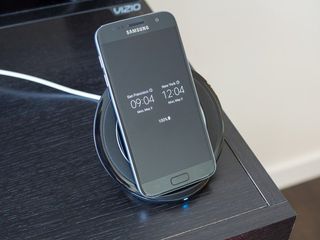Why you should look forward to Apple 'inventing' wireless charging

You'll be hearing a lot about wireless charging in the next few weeks, and that's because Apple just joined the Wireless Power Consortium, a group of like-minded companies with the goal of furthering a single standard for charging devices sans wires.
But Apple has taken its time making overtures towards wireless charging, choosing to forgo the innovative feature until the introduction of the Apple Watch in early 2015. But even that product doesn't adhere to the Qi standard overseen by the WPC, going against the trend of the rest of the phone industry in the process.
Wireless charging is not new. It's been around in some form since 2008, and products supporting Qi emerged in 2011. On Android, the first product of note to support it was the Nexus 4, and every Nexus device until the 6P supported it, too. Then the Galaxy S line began supporting it natively in 2015 with the Galaxy S6, and that's that.
These Android phones support wireless charging
But Google has since dropped wireless charging from its product lineup — the metal-clad Pixel and Pixel XL lack the feature, as did their predecessors, the Nexus 6P and 5X — and despite supporting it in its flagships Samsung doesn't really emphasize it anymore. So what's the deal?
At one point, it was supposed to be the ultimate convenience, but now it's just kind of cool.
At one point, it was supposed to be the ultimate convenience, a natural way to place a device somewhere — usually a puck or stand on a desk — but now, in light of ultra-fast charging standards like Quick Charge 3.0 and VOOC, the convenience of topping up sans wires has been largely upstaged by the mere act of juicing. Add to that fact the proliferation of the much more convenient USB-C standard, and it's understandable why wireless charging hasn't taken off the way many thought it would a few years ago.
It also hasn't helped that, despite its dominance and perceived "victory," Qi is not the only wireless charging game in town. In 2015, the smaller Power Matters Alliance merged with the even more obscure Alliance for Wireless Power to form AirFuel, of which AT&T, Samsung and Starbucks are members (though the two former are also members of WPC, for what it's worth), and the newly-formed entity is still trying to convince people that its solution is better. It's not, though it has been experimenting with resonance-based wireless charging, which opens up devices to the coveted idea of "spatial freedom."
Be an expert in 5 minutes
Get the latest news from Android Central, your trusted companion in the world of Android

Indeed, wireless charging likely won't find significant support until solutions are in place to facilitate "long-distance" charging — the idea that someone can place his or her phone anywhere on a surface and have it begin charging, even slowly. Right now, solutions from either WPC or AirFuel are constrained to precise placements.
Today, Samsung is the only game in town when it comes to wireless charging. LG may add it to its upcoming G6 flagship, but it's the Galaxy S7 series (and the now-deceased Galaxy Note 7) that have maintained demand. One reason for the tech's limited adoption is its material requirement: specifically, it's much more difficult to design a phone with wireless charging when its backplate is made of metal, since the material interferes with the magnetic field created by the inductive coils that produce the energy necessary to transfer electricity from the charger to the phone.
Today, Samsung is the only game in town when it comes to wireless charging, but that could soon change.
Samsung has designed around this problem by producing phones with glass backs, which have their own sets of problems, but the real solution to this is to develop wireless charging methods that are material-neutral. WPC and AirFuel have both spent years researching exactly that, but have yet to overcome the extra heat caused by the increased power necessary to overcome the metal's conductive nature. In 2015, Qualcomm announced a solution that would use AirFuel's Rezence standard to allow for charging through metal by physically connecting the power source to the phone casing itself, but so far no devices have incorporated it.
The other thing to think about is that, aside from the Nexus 4 and Nexus 5, wireless charging has largely been relegated to expensive flagships. Its growth depends on it going mainstream, which means cutting out confusion — a settling of the two standards will help — and getting it into as many mid-range devices as possible.

Circling back to Apple, its joining the Wireless Power Consortium, and potentially releasing an iPhone that supports Qi wireless charging, may have positive implications for the Android industry in general: greater interest in wireless charging from the public at large, which could lead to additional Android devices with it built in and accelerated development of solutions with that aforementioned spatial freedom. It may take credit for pushing the idea into the mainstream, but Android users shouldn't care: Qi is an open standard, and any "invention" from Apple will be adapted and improved upon by the industry as a whole.
Even AirFuel released a statement to that effect after it was revealed Apple aligned itself with the competition:
We're encouraged by the news that Apple is looking at wireless charging for their upcoming devices. Consumers not only want wireless charging, they want it to be second-nature, available when and where they need it.This is one of the many reasons AirFuel Alliance continues to support all wireless charging technologies, from inductive to resonant to RF. Whichever wireless charging technologies Apple ultimately considers incorporating into its next-gen phones, this is great news for consumers and for the industry as a whole. We welcome Apple to the wireless charging table.
For fans of wireless charging, regardless of which side of the platform aisle you stand, this is good news.
Daniel Bader was a former Android Central Editor-in-Chief and Executive Editor for iMore and Windows Central.

